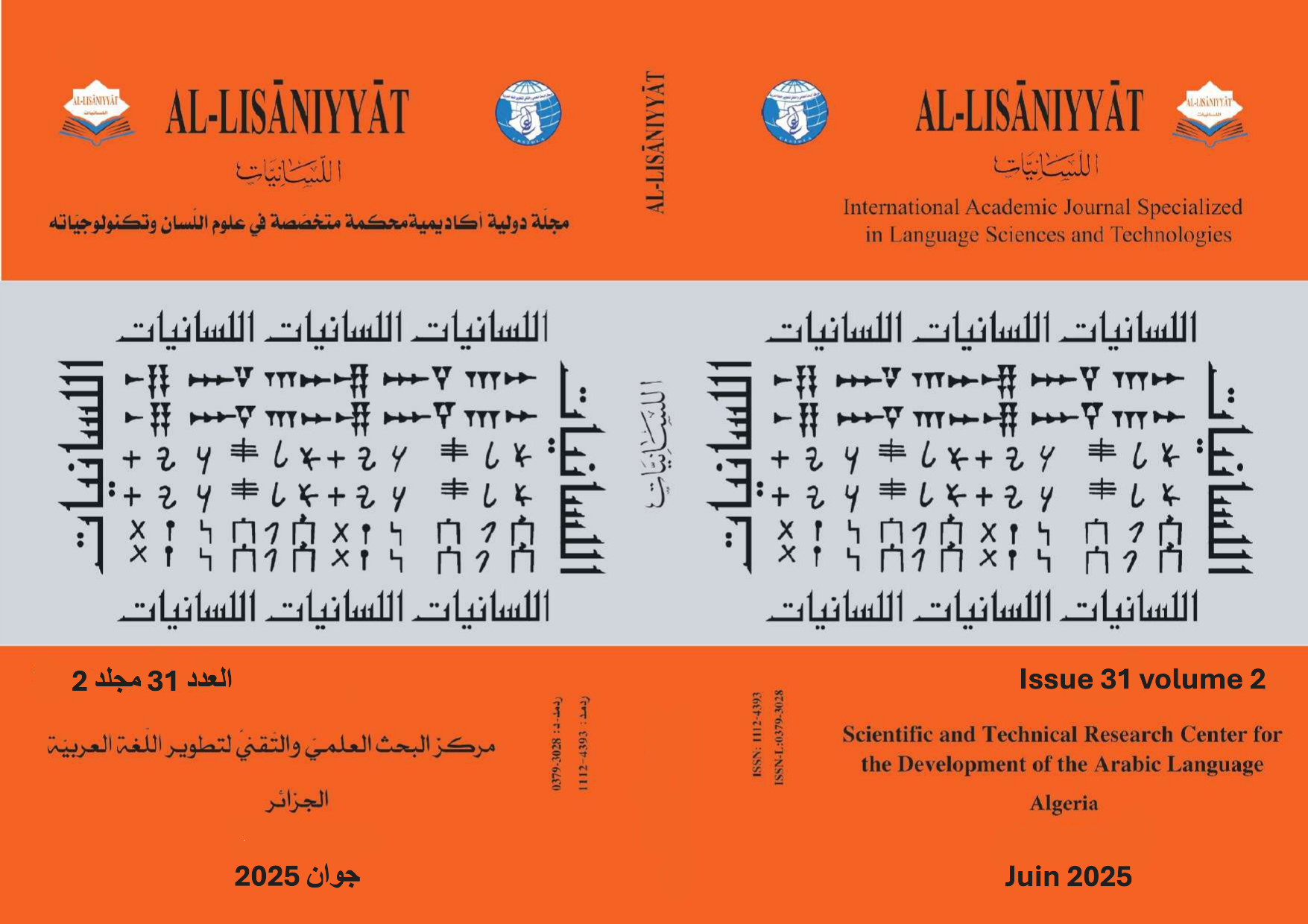تقصير الصوائت في العربية الوهرانية المنطوقة
##plugins.themes.bootstrap3.article.main##
الملخص
تتناول هذه الدراسة عملية تقصير الصوائت في اللهجة الوهرانية المنطوقة (WSA)، وهي لهجة من لهجات العربية الجزائرية المتداولة في المنطقة الشمالية الغربية من الجزائر. يستخدم الباحث تسجيلات وملاحظات ميدانية لخطاب عفوي لخمسين متحدثًا ومتحدثة من البالغين، من الناطقين الأصليين للوهرانية، لا يعانون من أية إعاقات، في سياقات طبيعية، كمادة تحليلية للدراسة.
تُظهر نتائج الدراسة أن تقصير الصوائت أو الحركات (VS)في الوهرانية يحدث في المقاطع المغلقة والمفتوحة على حد سواء. ففي حالة المقاطع المغلقة، يتم تقصير الصوائت لتفادي وجود مقاطع ثلاثية المورا (trimoraic). أما في المقاطع المفتوحة، فيتم تقصير الحركات الطويلة نتيجة لحذف الصوامت اللاحقة (coda)، مما يؤدي إلى تحول المقطع CVVC إلى مقطع مفتوح. وبما أن المقاطع من نوع CVV غير مقبولة في الوهرانية، يتم تقصير الصوائت، مما يؤدي إلى فقدان المورا.
##plugins.themes.bootstrap3.article.details##

هذا العمل مرخص حسب الرخصة Creative Commons Attribution-NonCommercial 4.0 International License.
المراجع
Abu-Salim, I. (1986), Vowel shortening in Palestinian Arabic: A metrical perspective. Lingua, 68(2-3), 223-240.
Benyagoub, L. (2017). A Moraically-Based Model of the Syllable in Bechar Arabic. Arabic Language, Literature & Culture, 2(2), 40-48.
Bernouss, M. (2007). A moraic approach to syllables: evidence of Moroccon Arabic. Iranian Journal of Language Studies (IJLS), 1(3),155-170
Bouhadiba, F. (1988). Aspects of Algerian Arabic Verb Phonology and Morphology. Unpublished Doctoral Dissertation, University of Reading.
Brame, M. (1970). Arabic Phonology: Implications for Phonological Theory and Historical Semitic. Unpublished Doctoral Dissertation, Massachusetts Institute of Technology.
Broselow, E. (1976). The phonology of Egyptian Arabic. Unpublished Doctoral Dissertation. Amherst, MA: University of Massachusetts.
Broselow, E. (1992). Parametric variation in Arabic dialect phonology. In E. Broselow, M. Eid,& J. McCarthy (eds.),Perspectives on Arabic Linguistics IV.Papers from the Fourth Annual Symposium on Arabic Linguistics, (pp.7-45). Amsterdam: John Benjamins.
Chomsky, N and Halle, M. (1968). The Sound Pattern of English. New York: Harper and Row.
Eid& J. McCarthy (eds.), Perspective on Arabic Linguistics II: Papers from the SecondSymposium, (pp. 1-54). Amsterdam: John Benjamnins.
Hayes, B. (1989). Compensatory Lengthening in moraic phonology. Linguistic Inquiry, 20, 253-306.
Hayward, K. (2000). Experimental Phonetics. Harlow, England: Longman.
Hyman, L. (1985). A theory of Phonological Weight. Dordrecht: Foris.
Kambuziya, A.K.Z. (2007). Vajshenasi: Rouykardha-ye Gha’ede-bonyad [Phonology: Rule-based approaches]. Tehran: Samt.
Kenstowicz, M. (1994).Phonology in Generative Grammar. Blackwell publishers: Cambridge, Massachusetts.
LaFond, B. (2024). Indo Latin vowel weakening in phonetic perspective. European Linguistics, 1-21. doi:10.1163/22125892-bja10032.
McCarthy, J., & Prince, A. (1986). Prosodic morphology. MA: University of Massachusetts, Amherst and Brandeis University. Rutgers Center for Cognitive Science (RuCCs) technical report, 32
McCarthy, J., & Prince, A. (1990, January). Prosodic morphology and templatic morphology. In Perspectives on Arabic linguistics II: papers from the second annual symposium on Arabic linguistics (pp. 1-54).
Myers, S. (1987). Vowel shortening in English. Natural Language and Linguistic Theory, 5(4), 485–518.
Nash, C. M. (2005). A phonetic and phonological approach to stress in Sinhala verbs, Santa Barbara Papers in Linguistics.
Sadeghi, A.A. (2001). Tahavol-e pasvand-e haselmasdarazpahlavi be farsi [The evolution of abstract suffix from Pahlavi to Persian]. Masa’el-e Tarikhi-e Zaban-e Farsi [Historical issues of Persian]. Tehran.
Sarmış, E. E., & Canalis, S. (2021). High vowel shortening in Turkish. In Proceedings of the Workshop on Turkic and Languages in Contact with Turkic (Vol. 6, pp. 5060-5060). https://doi.org/10.3765/ptu.v6i1.5060
Sheredi, N. (2015). Prosodic Processes in Two Dialects of Libyan Arabic: A Harmonic Serialism Approach (Doctoral dissertation, University of Essex).
Watson, J. C. (2002). The phonology and morphology of Arabic. Oxford University Press, USA.
